Métodos cerrados de optimización#
Sección Dorada#
Es similar al método de la bisección porque necesita un \(x_l\) y \(x_u\). Para hallar la posición de los puntos \(x_1\) y \(x_2\), se usa la sección dorada.
El objetivo de usar la sección dorada, es ahorrar costos computacionales porque con ella se logra hacer la menor cantidad de operaciones. Es decir, con la sección dorada, no se calcula el máximo ni el mínimo sino la posición de \(x_1\) y \(x_2\).

Hacemos \(R = \frac{l_2}{l_1}\)
Resolvamos por formula cuadrática
\(a = 1\), \(b = 1\), \(c=-1\)
Tomando solo el positivo:
R es la sección dorada, este valor permite que las proporciones sean óptimas. Su recíproco da el número de oro.

Algoritmo de la sección dorada#
A) calcular d como:
B) Calculamos \(x_1\) y \(x_2\) con la formula:
Siempre \(x_1 > x_2\) por la sección dorada.
C)
Si \(f(x_1) > f(x_2)\), el máximo está entre \(x_2\) y \(x_u\). Entonces, \(x_l = x_2\), \(x_2 = x_1\), \(x_0 = x_1\) y se recalcula \(x_1 = x_l + d\)
Si \(f(x_1) < f(x_2)\), el máximo está entre \(x_l\) y \(x_1\). Entonces, \(x_u = x_1\), \(x_1 = x_2\), \(x_0 = x_2\) y se recalcula \(x_2 = x_u - d\)
D) Repetir hasta convergencia.
Ahora se ve la ventaja de la sección dorada porqeu no hay que recalcular todos los pintos sino solo uno (1)
Error relativo#
Ejercicio#
Buscar el máximo de:
En el intervalo \(x_l=0\) y \(x_u=4\) con una tolerancia del 1%
import sympy as sp
import numpy as np
import pandas as pd
import matplotlib.pyplot as plt
# Definición de la función
x = sp.symbols('x')
f = 2*sp.sin(x) - ((x**2)/10)
# Intervalo inicial
xl, xu = 0, 4
# Veamos como queda la gráfica a la que vamos a calcularle el máximo
fig, ax = plt.subplots()
t = np.linspace(xl,xu,400)
y = [f.subs({x:xi}) for xi in t]
ax.plot(t,y)
ax.grid()
ax.set_title("Método de la sección dorada")
ax.set_xlim(xl-1,xu+1)
## Plano cartesiano (Ejes)
ax.vlines(x=0,ymin=min(y)-0.5,ymax=max(y)+0.5,color='k')
ax.hlines(y=0,xmin=min(t)-0.5,xmax=max(t)+0.5,color='k')
## Límites xl y xu
ax.vlines(x=xl, ymin=0, ymax=f.subs({x:xl}), color='g', linestyle='--',label=f"$x_l$ = {xl}")
ax.vlines(x=xu, ymin=0, ymax=f.subs({x:xu}), color='b', linestyle='--',label=f"$x_u$ = {xu}")
ax.set_title("$2 sin(x) - (x^2)/10$")
ax.legend()
<matplotlib.legend.Legend at 0x7eef5700e6b0>
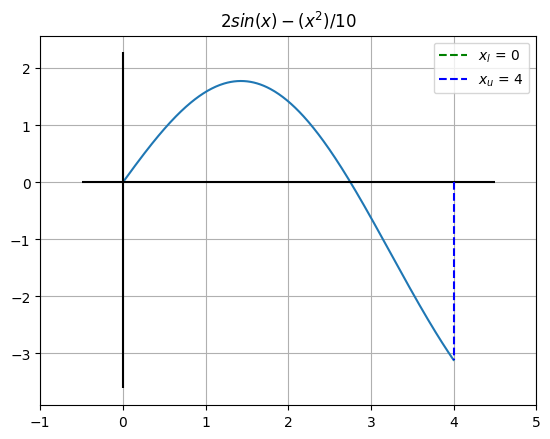
# Tolerancia (criterio de parada)
tol = 1
R = (np.sqrt(5)-1)/2 # Proporción áurea
error = tol + 1 # Inicializamos el error con un valor mayor que la tolerancia
it = 1 # Número de iteración
x0 = 0.01 # óptimo posible.
columnas = ['xl', 'xu', 'x1', 'x2', 'f(x1)', 'f(x2)', 'x0', 'error(%)']
tabla = pd.DataFrame(columns=columnas)
d = R*(xu-xl)
x1 = xl + d
x2 = xu - d
fx1 = round(f.subs({x:x1}),4)
fx2 = round(f.subs({x:x2}),4)
data = {'xl':[xl], 'xu':[xu], 'x1':[x1], 'x2':[x2], 'f(x1)':[fx1], 'f(x2)':[fx2], 'x0':[x0], 'error(%)':[round(error,2)]}
# @title Gráfica con los valores calculados
# Veamos como queda la gráfica en esta iteración
fig, ax = plt.subplots()
ax.plot(t,y)
ax.grid()
ax.set_title("Método de la sección dorada")
ax.set_xlim(xl-1,xu+1)
## Plano cartesiano (Ejes)
ax.vlines(x=0,ymin=min(y)-0.5,ymax=max(y)+0.5,color='k')
ax.hlines(y=0,xmin=min(t)-0.5,xmax=max(t)+0.5,color='k')
## Límites xl y xu
ax.vlines(x=xl, ymin=0, ymax=f.subs({x:xl}), color='g', linestyle='--',label=f"$x_l$ = {round(xl,3)}")
ax.vlines(x=xu, ymin=0, ymax=f.subs({x:xu}), color='b', linestyle='--',label=f"$x_u$ = {round(xu,3)}")
ax.set_title("$2 sin(x) - (x^2)/10$")
ax.vlines(x=x1, ymin=0, ymax=fx1, color='r', linestyle='--',label=f"$x_1$ = {round(x1,3)}")
ax.vlines(x=x2, ymin=0, ymax=fx2, color='purple', linestyle='--',label=f"$x_2$ = {round(x2,3)}")
ax.legend()
<matplotlib.legend.Legend at 0x7eef57048220>
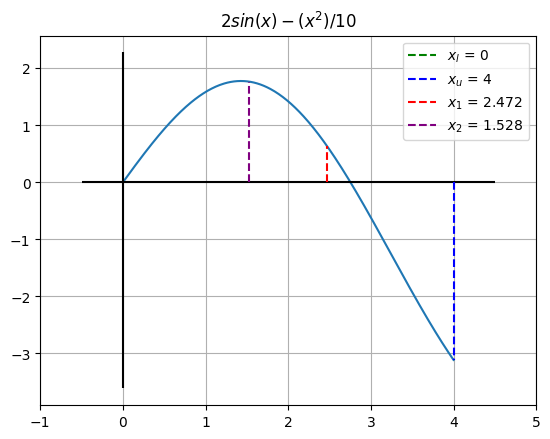
error = (1-R)*np.abs((xu-xl)/x0)*100
if fx1 > fx2:
xl = x2
x2 = x1
x0 = x1
x1 = xl + d
elif fx1 < fx2:
xu = x1
x1 = x2
x0 = x2
x2 = xu - d
data['x0'] = [x0]
data['error(%)'] = [error]
fila = pd.DataFrame(data = data)
tabla = pd.concat([tabla,fila],ignore_index=True)
tabla.head()
| xl | xu | x1 | x2 | f(x1) | f(x2) | x0 | error(%) | |
|---|---|---|---|---|---|---|---|---|
| 0 | 0 | 4 | 2.472136 | 1.527864 | 0.6300 | 1.7647 | 1.527864 | 15278.64045 |
## Siguiente interación
d = R*(xu-xl)
x1 = xl + d
x2 = xu - d
fx1 = round(f.subs({x:x1}),4)
fx2 = round(f.subs({x:x2}),4)
data = {'xl':[xl], 'xu':[xu], 'x1':[x1], 'x2':[x2], 'f(x1)':[fx1], 'f(x2)':[fx2], 'x0':[x0], 'error(%)':[round(error,2)]}
error = (1-R)*np.abs((xu-xl)/x0)*100
### Grafica
fig, ax = plt.subplots()
ax.plot(t,y)
ax.grid()
ax.set_title("Método de la sección dorada")
ax.set_xlim(xl-1,xu+1)
## Plano cartesiano (Ejes)
ax.vlines(x=0,ymin=min(y)-0.5,ymax=max(y)+0.5,color='k')
ax.hlines(y=0,xmin=min(t)-0.5,xmax=max(t)+0.5,color='k')
## Límites xl y xu
ax.vlines(x=xl, ymin=0, ymax=f.subs({x:xl}), color='g', linestyle='--',label=f"$x_l$ = {round(xl,3)}")
ax.vlines(x=xu, ymin=0, ymax=f.subs({x:xu}), color='b', linestyle='--',label=f"$x_u$ = {round(xu,3)}")
ax.set_title("$2 sin(x) - (x^2)/10$")
ax.vlines(x=x0, ymin=0, ymax=f.subs({x:x0}), color='orange', linestyle='--')
ax.vlines(x=x1, ymin=0, ymax=fx1, color='r', linestyle='--',label=f"$x_1$ = {round(x1,3)}")
ax.vlines(x=x2, ymin=0, ymax=fx2, color='purple', linestyle='--',label=f"$x_2$ = {round(x2,3)}")
ax.plot([x0],[f.subs({x:x0})],'*',label=f"$x_0 = ${round(x0,2)}")
ax.legend()
### Final Grafica
if fx1 > fx2:
xl = x2
x2 = x1
x0 = x1
x1 = xl + d
elif fx1 < fx2:
xu = x1
x1 = x2
x0 = x2
x2 = xu - d
data['x0'] = [x0]
data['error(%)'] = [error]
fila = pd.DataFrame(data = data)
tabla = pd.concat([tabla,fila],ignore_index=True)
tabla.head()
| xl | xu | x1 | x2 | f(x1) | f(x2) | x0 | error(%) | |
|---|---|---|---|---|---|---|---|---|
| 0 | 0 | 4 | 2.472136 | 1.527864 | 0.6300 | 1.7647 | 1.527864 | 15278.640450 |
| 1 | 0 | 2.472136 | 1.527864 | 0.944272 | 1.7647 | 1.5310 | 1.527864 | 61.803399 |
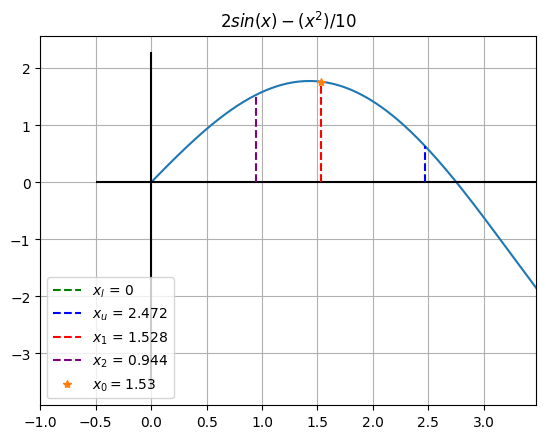
## Siguiente interación
d = R*(xu-xl)
x1 = xl + d
x2 = xu - d
fx1 = round(f.subs({x:x1}),4)
fx2 = round(f.subs({x:x2}),4)
data = {'xl':[xl], 'xu':[xu], 'x1':[x1], 'x2':[x2], 'f(x1)':[fx1], 'f(x2)':[fx2], 'x0':[x0], 'error(%)':[round(error,2)]}
error = (1-R)*np.abs((xu-xl)/x0)*100
### Grafica
fig, ax = plt.subplots()
ax.plot(t,y)
ax.grid()
ax.set_title("Método de la sección dorada")
ax.set_xlim(xl-1,xu+1)
## Plano cartesiano (Ejes)
ax.vlines(x=0,ymin=min(y)-0.5,ymax=max(y)+0.5,color='k')
ax.hlines(y=0,xmin=min(t)-0.5,xmax=max(t)+0.5,color='k')
## Límites xl y xu
ax.vlines(x=xl, ymin=0, ymax=f.subs({x:xl}), color='g', linestyle='--',label=f"$x_l$ = {round(xl,3)}")
ax.vlines(x=xu, ymin=0, ymax=f.subs({x:xu}), color='b', linestyle='--',label=f"$x_u$ = {round(xu,3)}")
ax.set_title("$2 sin(x) - (x^2)/10$")
ax.vlines(x=x0, ymin=0, ymax=f.subs({x:x0}), color='orange', linestyle='--')
ax.vlines(x=x1, ymin=0, ymax=fx1, color='r', linestyle='--',label=f"$x_1$ = {round(x1,3)}")
ax.vlines(x=x2, ymin=0, ymax=fx2, color='purple', linestyle='--',label=f"$x_2$ = {round(x2,3)}")
ax.plot([x0],[f.subs({x:x0})],'*',label=f"$x_0 = ${round(x0,2)}")
ax.legend()
### Final Grafica
if fx1 > fx2:
xl = x2
x2 = x1
x0 = x1
x1 = xl + d
elif fx1 < fx2:
xu = x1
x1 = x2
x0 = x2
x2 = xu - d
data['x0'] = [x0]
data['error(%)'] = [error]
fila = pd.DataFrame(data = data)
tabla = pd.concat([tabla,fila],ignore_index=True)
tabla.head()
| xl | xu | x1 | x2 | f(x1) | f(x2) | x0 | error(%) | |
|---|---|---|---|---|---|---|---|---|
| 0 | 0 | 4 | 2.472136 | 1.527864 | 0.6300 | 1.7647 | 1.527864 | 15278.640450 |
| 1 | 0 | 2.472136 | 1.527864 | 0.944272 | 1.7647 | 1.5310 | 1.527864 | 61.803399 |
| 2 | 0.944272 | 2.472136 | 1.888544 | 1.527864 | 1.5432 | 1.7647 | 1.527864 | 38.196601 |
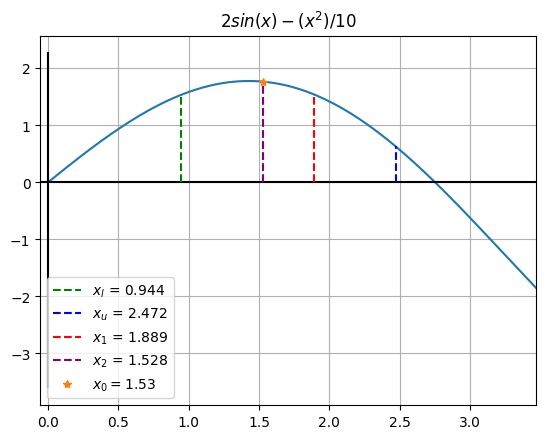
## Siguiente interación
d = R*(xu-xl)
x1 = xl + d
x2 = xu - d
fx1 = round(f.subs({x:x1}),4)
fx2 = round(f.subs({x:x2}),4)
data = {'xl':[xl], 'xu':[xu], 'x1':[x1], 'x2':[x2], 'f(x1)':[fx1], 'f(x2)':[fx2], 'x0':[x0], 'error(%)':[round(error,2)]}
error = (1-R)*np.abs((xu-xl)/x0)*100
### Grafica
fig, ax = plt.subplots()
ax.plot(t,y)
ax.grid()
ax.set_title("Método de la sección dorada")
ax.set_xlim(xl-1,xu+1)
## Plano cartesiano (Ejes)
ax.vlines(x=0,ymin=min(y)-0.5,ymax=max(y)+0.5,color='k')
ax.hlines(y=0,xmin=min(t)-0.5,xmax=max(t)+0.5,color='k')
## Límites xl y xu
ax.vlines(x=xl, ymin=0, ymax=f.subs({x:xl}), color='g', linestyle='--',label=f"$x_l$ = {round(xl,3)}")
ax.vlines(x=xu, ymin=0, ymax=f.subs({x:xu}), color='b', linestyle='--',label=f"$x_u$ = {round(xu,3)}")
ax.set_title("$2 sin(x) - (x^2)/10$")
ax.vlines(x=x0, ymin=0, ymax=f.subs({x:x0}), color='orange', linestyle='--')
ax.vlines(x=x1, ymin=0, ymax=fx1, color='r', linestyle='--',label=f"$x_1$ = {round(x1,3)}")
ax.vlines(x=x2, ymin=0, ymax=fx2, color='purple', linestyle='--',label=f"$x_2$ = {round(x2,3)}")
ax.plot([x0],[f.subs({x:x0})],'*',label=f"$x_0 = ${round(x0,2)}")
ax.legend()
### Final Grafica
if fx1 > fx2:
xl = x2
x2 = x1
x0 = x1
x1 = xl + d
elif fx1 < fx2:
xu = x1
x1 = x2
x0 = x2
x2 = xu - d
data['x0'] = [x0]
data['error(%)'] = [error]
fila = pd.DataFrame(data = data)
tabla = pd.concat([tabla,fila],ignore_index=True)
tabla.head()
| xl | xu | x1 | x2 | f(x1) | f(x2) | x0 | error(%) | |
|---|---|---|---|---|---|---|---|---|
| 0 | 0 | 4 | 2.472136 | 1.527864 | 0.6300 | 1.7647 | 1.527864 | 15278.640450 |
| 1 | 0 | 2.472136 | 1.527864 | 0.944272 | 1.7647 | 1.5310 | 1.527864 | 61.803399 |
| 2 | 0.944272 | 2.472136 | 1.888544 | 1.527864 | 1.5432 | 1.7647 | 1.527864 | 38.196601 |
| 3 | 0.944272 | 1.888544 | 1.527864 | 1.304952 | 1.7647 | 1.7595 | 1.527864 | 23.606798 |
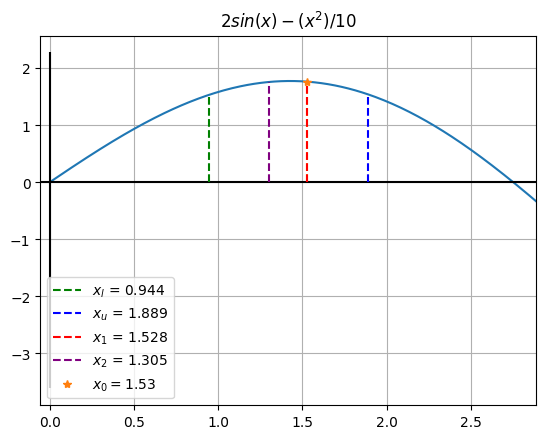
# Imprimimos el valor final
print("El óptimo está en: ", round(x0,2))
El óptimo está en: 1.53
Actividad#
Realizar el ajuste del algoritmo para que corra con cualquier tipo de función y para modificar sus límites y tolerancia hasta convergencia.
## TU CÓDIGO VA ACÁ
## HASTA ACÁ
Tarea#
Realice la versión del algoritmo que sea capaz de determinar el valor mínimo de una función ya que en estos ejercicios solo hallamos el máximo de las funciones.
## TU CÓDIGO VA ACÁ
## HASTA ACÁ
